 Photo from NUS
Photo from NUS
NUS pioneers waste-derived aerogels for radiative cooling and EMW absorption
Tests show that 0.5 cm of material produces a 2°C cooling effect.
National University of Singapore (NUS) experts have developed aerogels from waste materials for radiative cooling and electromagnetic wave (EMW) absorption.
Associate Professor Duong Hai-Minh from the Department of Mechanical Engineering under the NUS College of Design and Engineering led the development of aerogels.
The NUS experts used plastic waste to generate thin-film aerogels that act as thermal insulators and radiative coolers. These can be applied to any surface, such as roofs, to reduce internal temperature.
Compared to air conditioners that account for around 20% of electricity used in buildings, the newly-developed aerogel presents “a passive cooling alternative, leveraging the natural process of radiative cooling to dissipate heat into space without consuming energy,” NUS said.
When tested, 0.5 centimetres of the material produced a cooling effect of 2°C, achieved by emitting infrared heat into the surroundings while exhibiting good heat insulation, preventing heat absorption from the surrounding environment, NUS explained.
“This process involves using specially engineered aerogels to emit infrared radiation through the atmospheric ‘sky window’, effectively cooling surface temperatures below ambient levels,” said Duong.
“We are excited to be able to upcycle fibres from disposable polyethylene terephthalate (PET) bottles for the new aerogels designed for this purpose to help address the global plastic waste crisis.”
The team previously used PET fibres to produce aerogels, but the latest method is more energy-efficient, consuming about 97% less energy and reducing production time by 96%.
In January, NUS also produced aerogels that absorb EMWs in the X-band, characteristic of those used in weather monitoring and air traffic control.
The aerogel, with a thickness of about three millimetres or around 40 strands of human hair, absorbed 99.99% of EMW energy.
Across the entire X-band (8.2–12.4 GHz) of the electromagnetic spectrum, used primarily for radar systems, weather monitoring and air traffic control, the aerogel consistently showed its ability to absorb 90 per cent of EMW energy, NUS said.
“In addition to offering a wide absorption bandwidth of 1.2–2.2 GHz in the X-band, our aerogel is also about 10 times lighter than existing composites used for EMW absorption,” Duong said. “Unlike other composites, our aerogel requires no mixing with heavy polymer fillers before use.”
The cost of producing one square metre of aerogel, with a thickness of one centimetre, costs less than $100, which is less than similar commercial materials ranging from $180 to above $1,000, NUS said.






















 Advertise
Advertise






